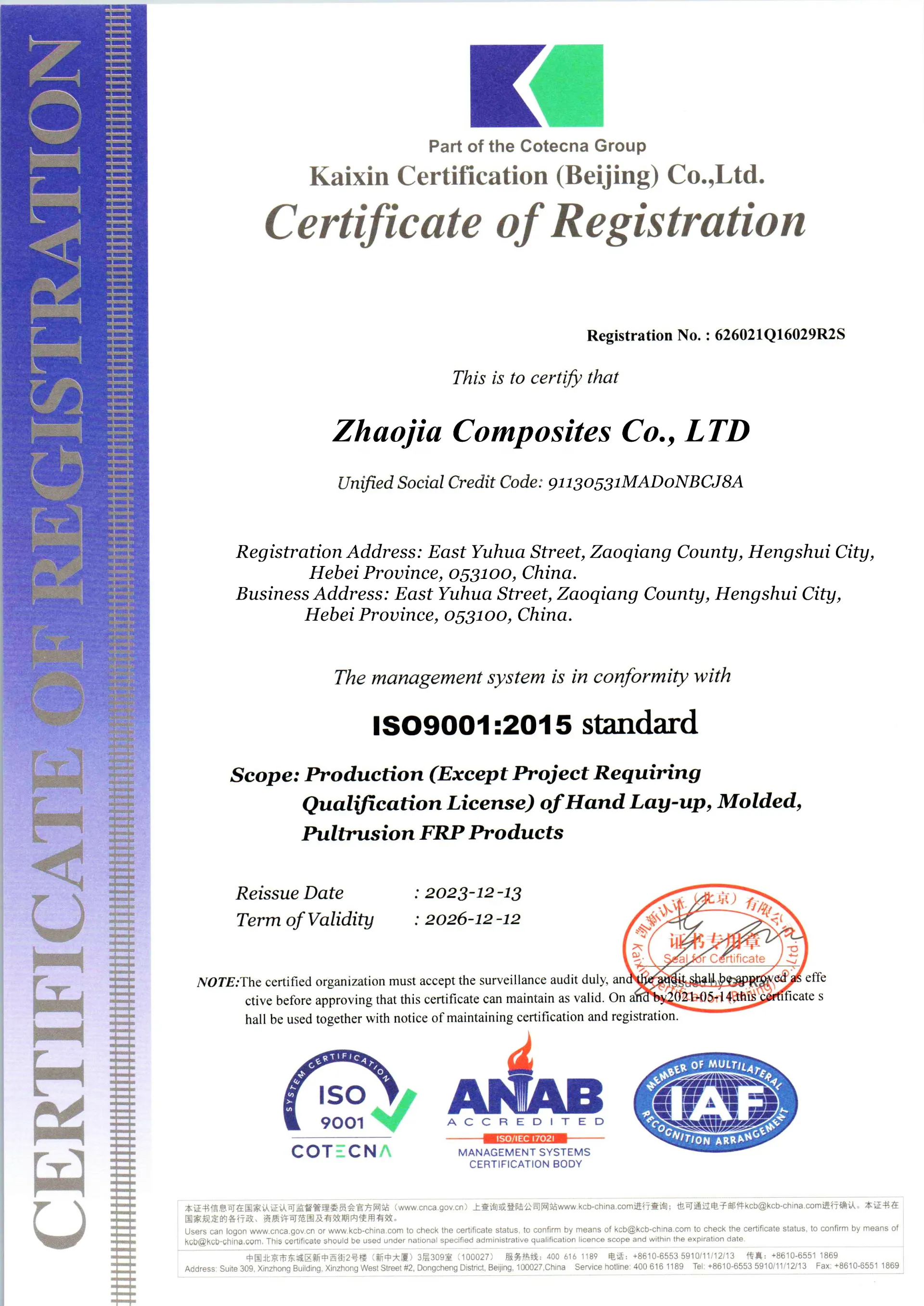loading...
- No. 9, Xingyuan South Street, Dongwaihuan Road, Zaoqiang County, Hengshui, Hebei, China
- admin@zjcomposites.com
- +86 15097380338
- Welcome to visit our website!
FRP Grating Solutions for Enhanced Safety and Durability in Industrial Applications
Understanding FRP Floor Grating A Comprehensive Overview
FRP (Fiber-Reinforced Plastic) floor grating has emerged as a crucial material in various industrial and commercial applications. As industries continue to seek solutions that offer durability, corrosion resistance, and lightweight characteristics, FRP floor grating stands out as a go-to choice. This article explores the properties, advantages, applications, and considerations associated with FRP floor grating.
What is FRP Floor Grating?
FRP floor grating is a manufactured product that combines a plastic matrix with reinforcing fibers, usually glass or carbon fibers, to create a composite material that exhibits superior strength and durability. The manufacturing process involves the infusion of resin into the fiber matrix, resulting in a lightweight yet robust structure that is ideal for flooring and walkways.
Key Properties
1. Corrosion Resistance One of the most significant advantages of FRP is its resistance to a wide range of chemicals. This property makes it particularly suitable for environments where exposure to harsh substances is common, such as in chemical processing plants, wastewater treatment facilities, and marine applications.
2. Lightweight Unlike traditional materials such as metal or concrete, FRP grating is significantly lighter, making it easier to install and handle. The reduction in weight also contributes to less structural load, which can be a crucial factor in certain construction scenarios.
3. Non-Conductive FRP is an excellent electrical insulator. This means it can be safely used in environments where electrical conductivity poses a risk, such as in electrical power plants and facilities with sensitive equipment.
4. Slip Resistance FRP grating surfaces can be designed to provide enhanced slip resistance. This feature is especially important in industrial settings where spills may occur, ensuring safety for personnel who work in these environments.
5. UV Resistance High-quality FRP materials are treated for ultraviolet (UV) resistance, preventing degradation from sun exposure. This property extends the lifespan of the grating, making it suitable for outdoor installations.
Advantages of FRP Floor Grating
- Cost-Effectiveness While the initial cost of FRP may be higher than some conventional materials, its longevity and minimal maintenance requirements often lead to lower total lifecycle costs.
- Customization FRP grating can be manufactured in various sizes, shapes, and colors, providing flexibility in design to meet specific project requirements. Customization also allows for integration with existing structures, enhancing aesthetic appeal.
- Ease of Installation Due to its lightweight nature, FRP grating can be easily cut and shaped on-site, significantly reducing installation time. Its modular design also allows for quick assembly and disassembly, which is advantageous in temporary installations.
frp floor grating

Applications
FRP floor grating finds extensive use across various sectors, including
- Chemical Processing Given its resistance to corrosive agents, FRP is ideal for use in chemical plants where traditional materials may fail.
- Wastewater Treatment In facilities where water and chemical exposure are constant, FRP grating provides a safe and durable flooring solution.
- Marine Applications Boat docks, piers, and offshore platforms often utilize FRP due to its waterproof characteristics and resistance to marine growth.
- Pharmaceuticals and Food Processing The ability to maintain hygiene and ease of cleaning makes FRP a preferred choice in environments where cleanliness is paramount.
Considerations for Installation
While choosing FRP floor grating, several factors should be considered
- Load Requirements Assessing the load requirements of the application is essential to ensure the chosen grating can support expected weights.
- Environmental Conditions Understanding the specific environmental conditions, including potential chemical exposure and UV light, aids in selecting the right type of FRP.
- Regulatory Compliance Ensure that the selected FRP grating meets relevant industry standards and regulations in terms of safety and performance.
Conclusion
FRP floor grating presents a versatile, durable, and cost-effective solution for various industries seeking reliable flooring options. Its unique combinations of features, including corrosion resistance, lightweight nature, and customizability, make it a preferred choice for many applications. As industries evolve and the need for innovative materials grows, FRP floor grating will continue to play a significant role in meeting modern engineering challenges.
-
The Rise of FRP Profiles: Strong, Lightweight, and Built to LastNewsJul.14,2025
-
SMC Panel Tanks: A Modern Water Storage Solution for All EnvironmentsNewsJul.14,2025
-
GRP Grating: A Modern Solution for Safe and Durable Access SystemsNewsJul.14,2025
-
Galvanized Steel Water Tanks: Durable, Reliable, and Ready for UseNewsJul.14,2025
-
FRP Mini Mesh Grating: The Safer, Smarter Flooring SolutionNewsJul.14,2025
-
Exploring FRP Vessels: Durable Solutions for Modern Fluid HandlingNewsJul.14,2025
-
GRP Structures: The Future of Lightweight, High-Performance EngineeringNewsJun.20,2025
